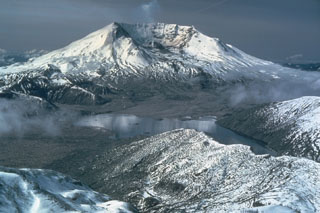Report on St. Helens (United States) — January 1985
Scientific Event Alert Network Bulletin, vol. 10, no. 1 (January 1985)
Managing Editor: Lindsay McClelland.
St. Helens (United States) Activity remains at background levels
Please cite this report as:
Global Volcanism Program, 1985. Report on St. Helens (United States) (McClelland, L., ed.). Scientific Event Alert Network Bulletin, 10:1. Smithsonian Institution. https://doi.org/10.5479/si.GVP.SEAN198501-321050
St. Helens
United States
46.2°N, 122.18°W; summit elev. 2549 m
All times are local (unless otherwise noted)
Seismicity, SO2 emission, and deformation of the composite lava dome remained at background levels through early February. The duration of the current quiet period was comparable to the longest previous interval between extrusion episodes, which separated the August 1982 extrusion from the onset of more than a year of continuous activity beginning in February 1983.
Very few earthquakes or surface events were recorded through early February. Rates of SO2 emission measured on 5 days in January and early February ranged from 76 ± 4 t/d on 22 January to 12 ± 5 t/d on 4 February. Two telemetering H2 monitors were installed on the dome in early January, one in a 70°C fumarole, the other in ambient air. Some variation in H2 values was observed, but more background data will be necessary before the significance of such variations can be determined. No tephra emissions have occurred since 24 September. USGS geologists noted that each prolonged lull in tephra emissions (ranging from 6-20 weeks) between 1982 and 1984 was followed by a moderate explosion.
Geological Summary. Prior to 1980, Mount St. Helens was a conical volcano sometimes known as the Fujisan of America. During the 1980 eruption the upper 400 m of the summit was removed by slope failure, leaving a 2 x 3.5 km breached crater now partially filled by a lava dome. There have been nine major eruptive periods beginning about 40-50,000 years ago, and it has been the most active volcano in the Cascade Range during the Holocene. Prior to 2,200 years ago, tephra, lava domes, and pyroclastic flows were erupted, forming the older edifice, but few lava flows extended beyond the base of the volcano. The modern edifice consists of basaltic as well as andesitic and dacitic products from summit and flank vents. Eruptions in the 19th century originated from the Goat Rocks area on the N flank, and were witnessed by early settlers.
Information Contacts: D. Swanson; J. Sutton, USGS CVO, Vancouver, WA; C. Jonientz-Trisler, University of Washington.

